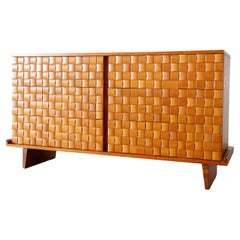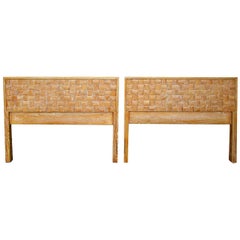Paul Laszlo Woven Basket
Vintage 1950s American Mid-Century Modern Dressers
Oak
Recent Sales
Vintage 1950s American Mid-Century Modern Beds and Bed Frames
Oak
Vintage 1950s American Mid-Century Modern Buffets
Oak
Vintage 1950s Planters, Cachepots and Jardinières
Rattan
Vintage 1950s American Mid-Century Modern Beds and Bed Frames
Oak
Paul Laszlo for sale on 1stDibs
The suave architect and interior designer Paul Laszlo made his reputation in Hollywood, where his clients included Barbara Stanwyck, Cary Grant and Elizabeth Taylor. He was aligned to no artistic or design movements, relying on his own carefully honed instincts to create his celebrated lounge chairs, tables, dressers and other furnishings. From the late 1930s to the 1960s, Laszlo’s name was a byword for sumptuous modernity among members of the smart set.
Born in Hungary in 1900, Laszlo learned about quality from his father, a prosperous furniture manufacturer. He studied design in Vienna and had his technical training in Stuttgart, Germany, where, at age 27, he established an upscale design business that gained an international reputation. Nine years later, with the Nazis in power, Laszlo, a Jew, left Germany for the United States and made his way to Los Angeles. There, he established an interior design office in Beverly Hills and was pleased to find that his Stuttgart credentials carried weight.
While he took many commercial assignments for American department stores, custom residential work was Laszlo’s stock in trade. He turned his hand to every element in a room, “down to the last ashtray,” Time magazine once wrote. Like his clients, Laszlo appreciated luxury — not the luxury of rare and precious materials, but the luxury of rich colors and textures, and deep comforts. He had a contemporary élan, exemplified by spaces that were bright, airy, uncluttered and up-to-date.
The classic earmarks of Laszlo’s furnishings are generous proportions and, in the case of his Paddle and Plank armchairs, namesake armrests that are flat and wide, the perfect spot to rest a cocktail. His case goods, tables and dining chairs have clean, elegant lines; they are simply formed yet warm, with interesting details such as woven veneer door fronts.
In recent years, Laszlo’s designs have found a new audience among fans of his easygoing modernism. Prices are in the neighborhood of $5,000 for his vintage cabinets, and from $8,000 to upwards of $20,000 for seating pieces, which are generally found in pairs or groups of six or more.
There was a reason that Laszlo’s work was so admired in the mid-20th century: every design contributes to an environment that is comfortable and elegant — at once robust and relaxed.
Find vintage Paul Laszlo furniture on 1stDibs.
A Close Look at mid-century-modern Furniture
Organically shaped, clean-lined and elegantly simple are three terms that well describe vintage mid-century modern furniture. The style, which emerged primarily in the years following World War II, is characterized by pieces that were conceived and made in an energetic, optimistic spirit by creators who believed that good design was an essential part of good living.
ORIGINS OF MID-CENTURY MODERN FURNITURE DESIGN
- Emerged during the mid-20th century
- Informed by European modernism, Bauhaus, International style, Scandinavian modernism and Frank Lloyd Wright’s architecture
- A heyday of innovation in postwar America
- Experimentation with new ideas, new materials and new forms flourished in Scandinavia, Italy, the former Czechoslovakia and elsewhere in Europe
CHARACTERISTICS OF MID-CENTURY MODERN FURNITURE DESIGN
- Simplicity, organic forms, clean lines
- A blend of neutral and bold Pop art colors
- Use of natural and man-made materials — alluring woods such as teak, rosewood and oak; steel, fiberglass and molded plywood
- Light-filled spaces with colorful upholstery
- Glass walls and an emphasis on the outdoors
- Promotion of functionality
MID-CENTURY MODERN FURNITURE DESIGNERS TO KNOW
- Charles and Ray Eames
- Eero Saarinen
- Milo Baughman
- Florence Knoll
- Harry Bertoia
- Isamu Noguchi
- George Nelson
- Danish modernists Hans Wegner and Arne Jacobsen, whose emphasis on natural materials and craftsmanship influenced American designers and vice versa
ICONIC MID-CENTURY MODERN FURNITURE DESIGNS
- Eames lounge chair
- Nelson daybed
- Florence Knoll sofa
- Egg chair
- Womb chair
- Noguchi coffee table
- Barcelona chair
VINTAGE MID-CENTURY MODERN FURNITURE ON 1STDIBS
The mid-century modern era saw leagues of postwar American architects and designers animated by new ideas and new technology. The lean, functionalist International-style architecture of Le Corbusier and Bauhaus eminences Ludwig Mies van der Rohe and Walter Gropius had been promoted in the United States during the 1930s by Philip Johnson and others. New building techniques, such as “post-and-beam” construction, allowed the International-style schemes to be realized on a small scale in open-plan houses with long walls of glass.
Materials developed for wartime use became available for domestic goods and were incorporated into mid-century modern furniture designs. Charles and Ray Eames and Eero Saarinen, who had experimented extensively with molded plywood, eagerly embraced fiberglass for pieces such as the La Chaise and the Womb chair, respectively.
Architect, writer and designer George Nelson created with his team shades for the Bubble lamp using a new translucent polymer skin and, as design director at Herman Miller, recruited the Eameses, Alexander Girard and others for projects at the legendary Michigan furniture manufacturer.
Harry Bertoia and Isamu Noguchi devised chairs and tables built of wire mesh and wire struts. Materials were repurposed too: The Danish-born designer Jens Risom created a line of chairs using surplus parachute straps for webbed seats and backrests.
The Risom lounge chair was among the first pieces of furniture commissioned and produced by legendary manufacturer Knoll, a chief influencer in the rise of modern design in the United States, thanks to the work of Florence Knoll, the pioneering architect and designer who made the firm a leader in its field. The seating that Knoll created for office spaces — as well as pieces designed by Florence initially for commercial clients — soon became desirable for the home.
As the demand for casual, uncluttered furnishings grew, more mid-century furniture designers caught the spirit.
Classically oriented creators such as Edward Wormley, house designer for Dunbar Inc., offered such pieces as the sinuous Listen to Me chaise; the British expatriate T.H. Robsjohn-Gibbings switched gears, creating items such as the tiered, biomorphic Mesa table. There were Young Turks such as Paul McCobb, who designed holistic groups of sleek, blond wood furniture, and Milo Baughman, who espoused a West Coast aesthetic in minimalist teak dining tables and lushly upholstered chairs and sofas with angular steel frames.
As the collection of vintage mid-century modern chairs, dressers, coffee tables and other furniture for the living room, dining room, bedroom and elsewhere on 1stDibs demonstrates, this period saw one of the most delightful and dramatic flowerings of creativity in design history.


